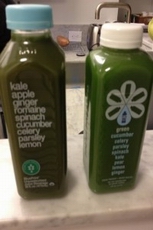
But beware: There are two separate processes the juice companies are using. One process results in a three-day shelf life and the other gives you a 30-day shelf life. But the juices are packaged up similarly and cost the same—$8 to $10 for 12 oz. And, all juices are delivered across the U.S., allowing regular people and celebrities alike to do their three-day juice fast right from home.
Some companies, like The Pressed Juicery use the hydraulic press, which grinds up the fruit and then applies thousands of pounds of pressure to cold press out every drop of juice. They may spend a few thousand on one of Dr. Walkers Hydraulic Press Juicers (nwjcal.com), which turns raw produce into a mash (releasing all the vitamins and “enzymes") and then applies extreme pressure (6,000 PSI) to extract the juice. There is minimal air contact, so the final product is a fresh-tasting, smooth, raw beverage that can maintain freshness for up to three days in the fridge.
Other companies are taking advantage of the HPP, or High Pressure Process, for their raw juices. This process is very expensive and is currently being used for products like Blueprint Juice and Harmless Coconut. These juices taste just as good as the hydraulic pressed juices but are actually SAFER! The bacteria load is reduced by high pressure (instead of heat) after the juice is in its bottle, and this allows them to last up to 30 days in the refrigerator, just like a heat-pasteurized juice.
So, while this juice craze has taken the nation by storm (or at least it feels that way to me, living in northern California) all the companies, whether they're using HPP or hydraulic press processes, are packing them up and shipping them all over the place in very similar looking bottles and with similar prices. It’s easy to get confused about which bottles are HPP and which are not, and it is important to know the difference. I personally would not want to receive a hydraulic pressed juice in the mail—too much handling going on there, and too many opportunities for a breakdown in the system. I would only want to buy it in a store that presses and refrigerates, and monitors the time from press to purchase.
Now, the HPP juices are another story. With their reduced bacterial loads and longer shelf life, and the fact that they are made in a manufacturing plant that probably has a vigorous safety and quality-testing program in place, I feel better somehow going with those juices. There are only a few facilities that practice HPP, and there are many hydraulic pressed juice joints. I don’t know them and I don't know their families!
HPP is a very expensive process and many juice companies cannot afford to go down that path. However, with potential pathogens lurking in raw “non-HPP-ed" juices, and with the pricing being roughly the same, isn’t it worth it to get the safer versions? Less than a year ago it was difficult to find these HPP juices, but now they are everywhere, even in Starbucks. So play it safe, go HPP (read the packaging, they usually say HPP if they are, or have some sort of a warning if they are not) and don’t order your hydraulic juices online.







